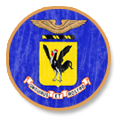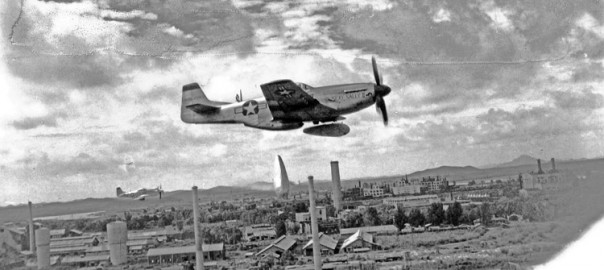The “Red Capital”—Pyongyang—received “considerable attention during the month” of August 1951.
Three “maximum efforts” missions were sent this month to attack Pyongyang, the 18th FBW report noted. “Maximum effort” missions were a group mission, each squadron putting up sixteen aircraft for each mission. These missions were over and above the squadron’s primary mission of “vigorous close support to the ground forces,” during which it flew an average of 12 sorties per day.

Two of the maximum effort attacks on Pyongyang were made on 14 August 1951. The heavy losses in pilots prompted a highly classified and uncharacteristically stiff letter from the 18th Wing Commander, Colonel T.C. Rogers to the Fifth Air Force Commanding General.
“Attacks on targets as heavily defended as Pyongyang by F-51’s are not considered to be profitable when made under conditions which lessen the maximum striking potential of the airplane.”
“Very intense, accurate flak was encountered on the afternoon mission of 14 August, both into and out of the target area,” Rogers continued. “This condition did not exist in the morning attack, where the element of surprise was present. Axes of attack were all as directed by 5th AF except for the afternoon attack on target #1 which was changed to avoid radio antennae.”
Losses in the two strikes on 14 August for the Wing included two pilots KIA, three pilots MIA, six aircraft lost before returning to base, and four aircraft so heavily battle damaged that they were transferred to the 18th Maintenance Squadron.
Rogers recommended that “maximum effort attacks against heavily defended areas be made only when the striking force is able to employ its maximum payload. Staging from any forward base might obviate the use of external fuel tanks…permitting each airplane to carry…two 500# bombs.”
Damage assessments and observations by pilots should be “given more weight in target selection,” Rogers suggested. And, squadron or flight leaders should be “given discretion in the choice of axes of attack against specific targets.” Rogers concluded by urging that
“attacks against heavily defended areas be so planned and spaced as to afford the striking force the advantage of surprise.”

Major Murrit Davis, Commander, 39th Fighter-Interceptor Squadron

“On 14 August the squadron joined in a group ‘gaggle’ over Pyongyang,” the 39th Squadron reported. On the morning raid Major Murrit H. Davis, the Squadron Commander, suffered heavy damage to the right wing tip of his Mustang when the tip struck a cable over the target area and Captain Wagner’s aircraft had a large portion of the right horizontal stabilizer shot away. However, both aircraft made it back to K-10 safely.
That afternoon, Robert E. Sandlin in his unpublished manuscript “The Cobra in the Clouds Strikes Again,” the whole squadron was “again scheduled for a second mission on Pyongyang to again strike military targets in the area. Major Davis led his flight in low over the target area and just after releasing their napalm were struck by a tremendous amount of ground fire. The results were tragic for the 39th. Major M. H. Davis, Captain John Horn, Operations Officer, and his wingman were all shot down and killed. Major Jack A. Davis assumed Command of the 39th Fighter Squadron.”
The monthly report filed by the 39th FIS noted in the afternoon raid over the same target, Major Davis, Captain John L. Horn and Captain John F. Grossman failed to return. Major Davis received battle damage in the coolant system while over the target and insisted on circling over the immediate target area to determine the whereabouts of the other two missing pilots. He finally left the area and started south, but his engine had over-hearted and he subsequently crashed in enemy territory without bailing out. Captain Horn, the Operations Officer, was flying an F-51 with a K-25C camera and after his flight dropped their napalm he made a 180-degree turn back across the target to take photos of damage inflicted. No one saw him after he dropped his napalm and turned back over the area, but it was assumed he was hit by the intense enemy ground fire and crashed in the immediate target area.
In early September, Colonel T.C. Rogers, 18th FBW Commander, received a letter from Margaret Davis, writing about her husband, Major Murrit H. Davis, now missing in action. She expressed her appreciation and that of Davis’ mother for the letters Rogers had sent them regarding their husband and son.
“I am, of course, eager to know everything possible about the crash, and your letter contained much more information than the first sparse account received from Washington,” she said. “Although I fully realize that the picture is very black indeed and offers very little encouragement for clinging to the belief that my husband survived the crash, I do have that belief and will hold to it. It is a comfort to know that the men of the 18th Fighter-Bomber Wing share my concern during this period of great anxiety. Major Davis was very proud to be a part of the 18th Fighter-Bomber Wing, and of the 39th Fighter-Interceptor Squadron. It makes me very proud to hear that in return he was admired and respected by all of his associates,” she concluded.
Rogers replied to Margaret Davis on 16 September by noting that he fully realized “how difficult this war is for wives and parents. Sometimes I think it is worse for them than for the men actually engaged in combat,” Rogers observed. “I have received other letters similar to yours,” he continued, “in which wives cling to every shred of hope. I wish there were some assurance I could give you. As you probably know, unless positive proof of death can be established a man must be reported as missing in action. Dave’s chances of survival are extremely slim,” he pointed out.
“Mrs. Davis, your husband was a very gallant man,” Rogers concluded, “his thoughts were always first for his pilots and men. I was waiting at his operations office when his squadron returned from the mission on the afternoon of 14 August–never have I seen a group of pilots and men more grief stricken. They would have followed Dave anywhere. He has a living memorial in the hearts of his men. We all share with you the hope that he may have survived.”
Excerpted from Truckbusters from Dogpatch, the Combat Diary of the 18th Fighter-Bomber Wing in the Korean War, 1950-1953.
© Copyright 2016 BelleAire Press, LLC
 Truckbusters
Truckbusters 





